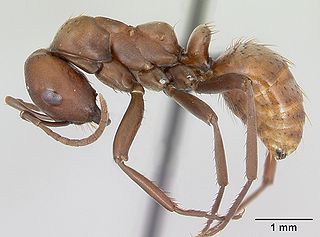
The Aegadian Islands are a group of five small mountainous islands in the Mediterranean Sea off the northwest coast of Sicily, Italy, near the cities of Trapani and Marsala, with a total area of 37.45 square kilometres (14.46 sq mi).

Formica laminate is a laminated composite material invented at the Westinghouse Electric Corporation in the United States in 1912. Originally used to replace mica in electrical applications, it has since been manufactured for a variety of applications. Today, the product is produced by New Zealand-based Formica Group, and has been since 2007. The word Formica refers to the company's classic product: a heat-resistant, wipe-clean laminate of paper or textile with melamine resin.

The Formica rufa group is a subgeneric group within the genus Formica, first proposed by William Morton Wheeler. This group contains the mound-building species of Formica commonly termed "wood ants" or "thatch-mound ants", which build prominent nests consisting of a mound of grass, litter, or conifer needles. The species Formica rufa or the red wood ant is the type species of this sub group.

Formica rufa, also known as the red wood ant, southern wood ant, or horse ant, is a boreal member of the Formica rufa group of ants, and is the type species for that group. It is native to Europe and Anatolia but is also found in North America, in both coniferous and broad-leaf broken woodland and parkland. Workers are bicolored red and brownish-black, with a dorsal dark patch on the head and promensonotum, and are polymorphic, measuring 4.5–9 mm in length. They have large mandibles and like many other ant species they are able to spray formic acid from their abdomens as a defence. Formic acid was first extracted in 1671 by the English naturalist John Ray by distilling a large number of crushed ants of this species.

Polyergus, also called Amazon ants, is a small genus of 14 described species of "slave-raiding" ants. Its workers are incapable of caring for brood, in part due to their dagger-like, piercing mandibles, but more importantly, because in the evolution of their parasitism on certain species of the host genus Formica, they have lost the "behavioral wiring" to carry out even rudimentary brood care, or even to feed themselves. Polyergus workers exist in essence as a specialized brood-acquiring caste in their mixed Polyergus/Formica colonies, maintaining the Formica worker force by robbing brood, especially pupae, of particular species in the closely related genus Formica in massive colony-to-colony raids. The captured ants are generally referred to as "slaves" in scientific and popular literature, though recent attempts have been made to apply other human cultural models, such as describing the Polyergus individuals of a colony as "raiders" or "pirates" or "kidnappers" and the Formica workers as "helper-ants", or "domesticated animals". Biologists describe the system as parasitism by "dulosis" (slavemaking) by Polyergus on the host Formica species.

Formica aquilonia, also called the Scottish wood ant, is a species of wood ant of the genus Formica which are widely distributed in Europe and Asia, occurring from Scandinavia in the north to Bulgaria and Italy in the south, and from the UK eastwards through France and Germany to Russia, while they are also found in the coastal areas of the Sea of Okhotsk in eastern Siberia. They live mainly in coniferous forests but they do also occur in some deciduous woodlands.

Formica pratensis, the black-backed meadow ant, is a species of European red wood ant in the family Formicidae.

Formicoxenus nitidulus, or the shining guest ant, is a species of ant in the subfamily Myrmicinae. It is found in Austria, Denmark, Finland, France, Germany, Great Britain, Italy, Norway, Poland, Sweden, and Switzerland.

Polyergus breviceps is a species of ant endemic to the United States. It is a social parasite of other ants, namely of Formica gnava but also of Formica occulta and Formica argentea. Polyergus is an inquiline parasite, having lost its ability to take care of its young and themselves. "The workers do not forage for food, feed the young or the queen, or even clean up their own nest". To survive, Polyergus workers raid Formica nests to steal the pupae—which, once hatched, become workers of the mixed nest. This sort of relationship is not unique, of the approximately 8,800 species of ants, at least 200 have evolved some form of symbiotic relationship with one another. What makes Polyergus special is the way a newly mated queen can, all by herself, take over a Formica nest and start a new colony.

Formica sanguinea, or blood-red ant, is a species of slave-maker ant in the genus Formica characterized by the ability to secrete formic acid. It ranges from Central and Northern Europe through Russia to Japan, China, the Korean Peninsula, Africa and also the United States. This species is coloured red and black with workers up to 7 mm long.

Mauro Abel Formica is an Argentine footballer who plays as an attacking midfielder for Newell's Old Boys in the Argentine Primera División.
He is nicknamed El Gato.
Lautaro Roque Formica is an Argentine football player currently playing for Deportivo Morón.
In the 10th edition of Systema Naturae, Carl Linnaeus classified the arthropods, including insects, arachnids and crustaceans, among his class "Insecta". Insects with membranous wings, including bees, wasps and ants were brought together under the name Hymenoptera.

Salvatore Formica, best known as Rino Formica, is a former Italian politician.

Paul Formica is a Republican member of the Connecticut Senate, representing the 20th District since 2015.

Formica subsericea is a species of ant in the genus Formica. It is found in the eastern United States and Canada. Workers of this species are incredibly fast and quite timid. Workers of this species are commonly found working as slaves in Polyergus colonies. Nuptial flights typically occur in July or August. It is often confused with another Formica species, Formica Fusca.













